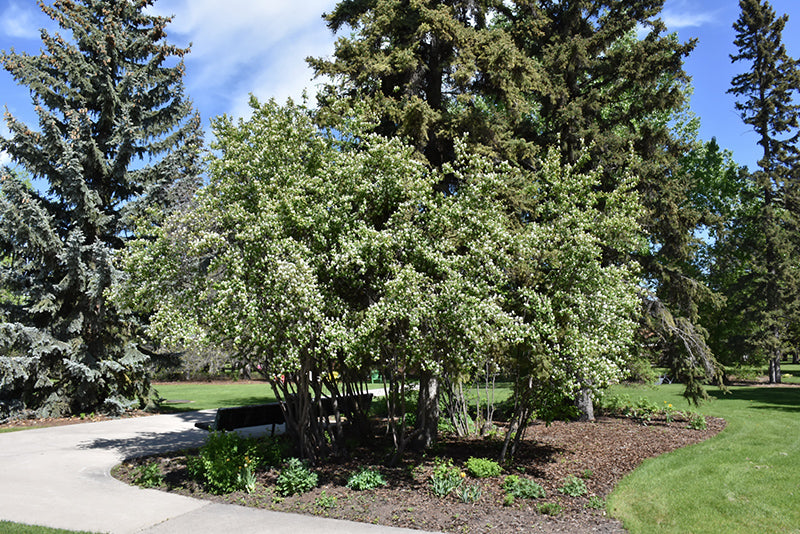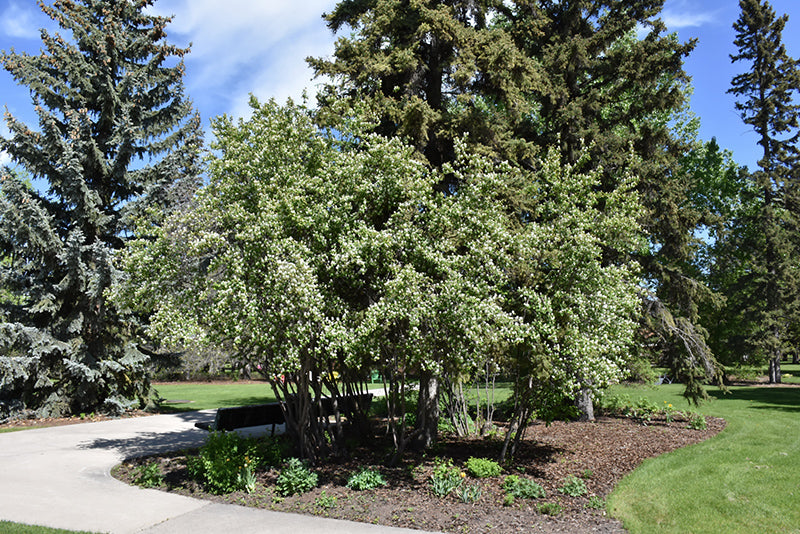Riverdene Garden Center
Thiessen Saskatoon
Thiessen Saskatoon
Couldn't load pickup availability
Amelanchier alnifolia ‘Thiessen’
Thiessen Saskatoon is a large, fast-growing, fruit-bearing shrub or small tree that produces sweet, juicy, blueberry-like berries in early summer. It is cold-hardy (Zone 2-7), drought-tolerant, and easy to grow, making it an excellent choice for home orchards, shelterbelts, edible landscapes, and wildlife gardens in Southwest Saskatchewan. This variety is known for its large berries (up to 17mm in diameter), excellent flavor, and high yields.
Planting & Location
- Hardiness Zone: 2-7 (very winter-hardy, ideal for prairie climates)
- Mature Size: 10-15 feet tall, 6-12 feet wide
- Growth Rate: Fast (12-24 inches per year)
- Sunlight Needs: Full sun to partial shade (best fruit production in 6+ hours of direct sun)
-
Soil Preference:
- Prefers well-drained, loamy soil.
- Tolerates clay, sandy, and slightly alkaline soils.
- Avoid soggy or compacted soil—well-draining soil is essential for healthy roots.
- Spacing: 6-10 feet apart for hedging, 10-15 feet apart for individual plantings.
Watering
- Young Plants (First Year): Water deeply 1-2 times per week to establish roots.
- Established Shrubs: Drought-tolerant but benefits from weekly deep watering during dry spells.
- Avoid Overwatering: Prefers moderate soil moisture, but roots do not like standing water.
Fertilizing
- First Year: No fertilizer needed—focus on root establishment.
-
Mature Plants:
- Apply a balanced fertilizer (e.g., 10-10-10) in early spring to encourage growth and fruiting.
- Organic alternative: Compost or well-rotted manure in spring.
Pruning & Maintenance
- Best Time to Prune: Late winter to early spring, before new growth starts.
-
How to Prune:
- Remove dead, diseased, or weak branches to improve airflow.
- Thin out older branches (over 5 years old) to encourage new, productive growth.
- Can be maintained as a multi-stemmed shrub or pruned into a small tree.
Fruit & Pollination
- Bloom Time: Late spring (May)
- Berry Ripening: Late June to early July
- Fruit Size: Large (up to 17mm diameter)
- Flavor: Sweet, mildly nutty, and juicy—great for fresh eating, baking, and jams
- Self-Pollinating: Yes, but better yields when multiple plants are nearby
- Attracts: Bees, butterflies, and birds
Pest & Disease Management
Resistant to: Cold, drought, and urban pollution
Common Pests:
-
Saskatoon Sawfly – Larvae feed on berries.
- Solution: Handpick affected fruit or apply insecticidal soap.
-
Aphids – Can cause curled leaves and sticky honeydew.
- Solution: Spray with insecticidal soap or introduce ladybugs.
-
Birds – Love to eat the berries.
- Solution: Use bird netting or plant extra for wildlife.
Common Diseases:
-
Entomosporium Leaf & Berry Spot – Causes dark spots on leaves and fruit.
- Solution: Improve airflow, remove infected leaves, and apply fungicide if needed.
-
Fire Blight – Affects stems and leaves, causing wilting and dieback.
- Solution: Prune affected branches 8-12 inches below infection and sanitize pruning tools.
Winter Protection
- Highly winter-hardy—no special protection needed.
- Mulching: Apply 2-4 inches of mulch around the base (not touching the trunk) to insulate roots.
- Deer & Rodents: Protect young plants with wire mesh if browsing is an issue.
Landscape Uses
Ideal for edible landscapes and home orchards
High-yielding variety with large, sweet berries
Great for hedges, windbreaks, and wildlife gardens
Cold-hardy and drought-tolerant
Attracts pollinators and birds
Additional Notes:
- Thiessen Saskatoon is one of the best cultivars for fresh eating, producing bigger berries and fewer suckers compared to other Saskatoon varieties.
- Lifespan: 40+ years with proper care.
- Works well in rows, mixed hedges, or as a specimen shrub.
Photo courtesy of Millcreek Nursery
Share


